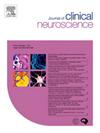一节段或两节段颈椎前路椎间盘切除术和融合术后C5麻痹:发生率和神经系统恢复在一项回顾性神经外科多中心研究中
IF 1.9
4区 医学
Q3 CLINICAL NEUROLOGY
引用次数: 0
摘要
背景:C5麻痹是颈椎手术后常见的并发症,尤其是后路手术后。虽然已经提出了几个危险因素,但颈椎前路椎间盘切除术和融合(ACDF)后C5麻痹的发生率仍然知之甚少。本研究旨在阐明与ACDF后C5麻痹相关的危险因素和神经功能恢复。方法:回顾性纳入并分析2018年1月至2022年12月期间在神经外科培训计划的三个机构中接受一级或二级ACDF的330例患者。收集了人口统计学、外科和放射学数据。结果:16例(4.8%)患者术后发生C5性麻痹,术前有症状(神经根病或神经根脊髓病)和二级ACDF (p值分别为0.008和0.018)的患者发生率明显较高。没有其他人口统计学或放射学因素与C5麻痹相关。16例患者中有11例(68.8%)在术后1天内出现C5麻痹(早发组),而其余5例在术后4至15天出现症状(晚发组)。术后1年,迟发组C5麻痹的恢复优于早发组(100% vs 44.4%)。结论:尽管神经系统预后良好,但外科医生应认识到一级或二级ACDF后C5麻痹的可能性。acdf后C5麻痹发生的时间可能受到直接损伤、缺血再灌注损伤等机制的影响,影响恢复预后。仔细的外科手术可能是成功的关键。本文章由计算机程序翻译,如有差异,请以英文原文为准。
C5 palsy following one- or two-level anterior cervical discectomy and fusion: Incidence and neurological recovery in a retrospective neurosurgical multicenter study
Background
C5 palsy is a frequent complication following cervical spine surgery, particularly after posterior approaches. Although several risk factors have been proposed, the incidence of C5 palsy after anterior cervical discectomy and fusion (ACDF) remains less well understood. This study aims to elucidate the risk factors and neurological recovery associated with C5 palsy following ACDF.
Methods
A total of 330 patients who underwent one or two-level ACDF between January 2018 and December 2022 across three institutions within the neurosurgical training program were retrospectively included and analyzed. Demographic, surgical, and radiological data were collected.
Results
Sixteen (4.8 %) patients developed postoperative C5 palsy, with a significantly high incidence observed in patients exhibiting preoperative symptoms (radiculopathy or radiculomyelopathy) and undergoing two-level ACDF (p-values 0.008 and 0.018, respectively). No other demographic or radiological factors were associated with C5 palsy. Eleven of 16 (68.8 %) patients experienced C5 palsy within 1 day post-surgery (early-onset group), whereas the remaining five developed symptoms between 4 to 15 days post-surgery (late-onset group). At one year post-surgery, the late-onset group demonstrated superior recovery from C5 palsy compared to the recovery noted in the early-onset group (100 % vs 44.4 %).
Conclusions
Surgeons should be cognizant of the potential for C5 palsy following one- or two-level ACDF, despite generally favorable neurological outcomes. The timing of C5 palsy onset post-ACDF, potentially influenced by mechanisms such as direct injury and ischemia–reperfusion injury, could impact the recovery prognosis. Careful surgical procedure might be the key to success.
求助全文
通过发布文献求助,成功后即可免费获取论文全文。
去求助
来源期刊

Journal of Clinical Neuroscience
医学-临床神经学
CiteScore
4.50
自引率
0.00%
发文量
402
审稿时长
40 days
期刊介绍:
This International journal, Journal of Clinical Neuroscience, publishes articles on clinical neurosurgery and neurology and the related neurosciences such as neuro-pathology, neuro-radiology, neuro-ophthalmology and neuro-physiology.
The journal has a broad International perspective, and emphasises the advances occurring in Asia, the Pacific Rim region, Europe and North America. The Journal acts as a focus for publication of major clinical and laboratory research, as well as publishing solicited manuscripts on specific subjects from experts, case reports and other information of interest to clinicians working in the clinical neurosciences.
 求助内容:
求助内容: 应助结果提醒方式:
应助结果提醒方式:


